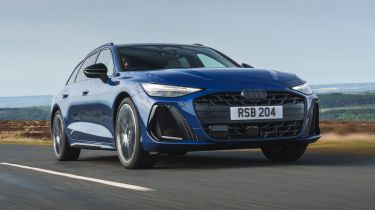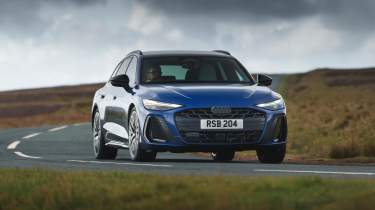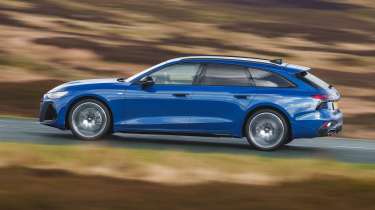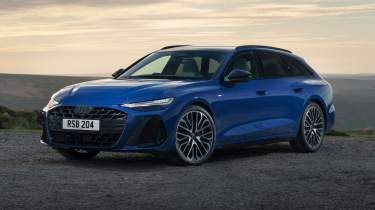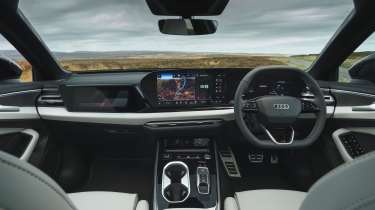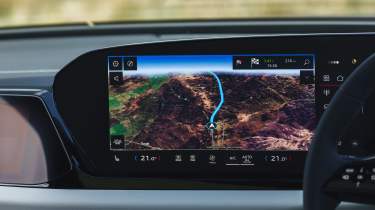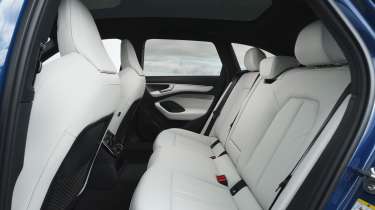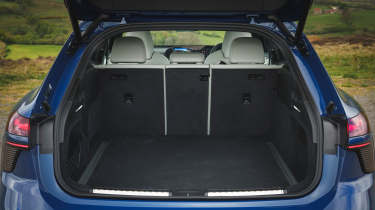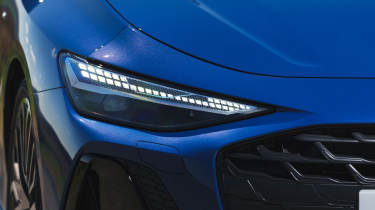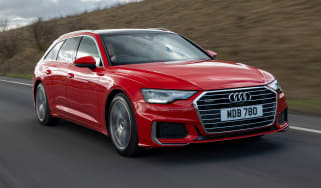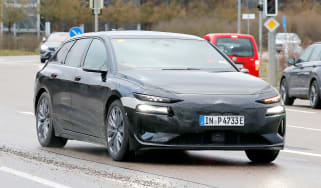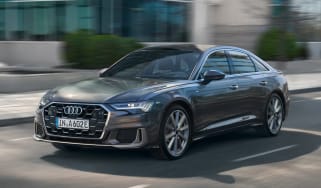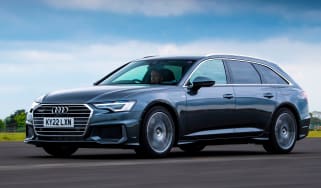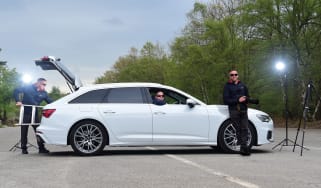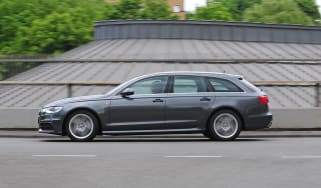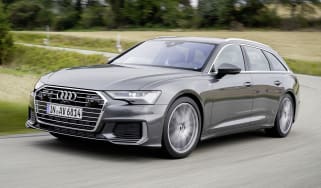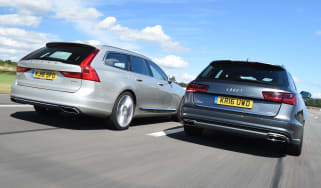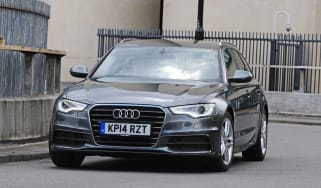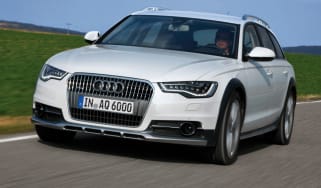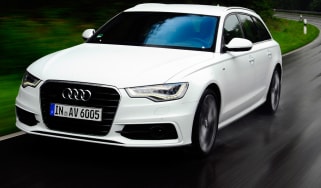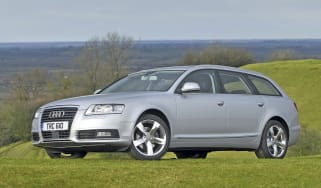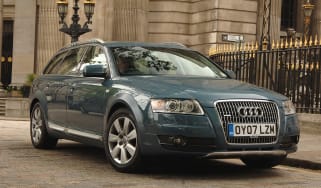Audi A6 Avant review
Sleek looking A6 Avant estate is comfortable and packed with tech, but boot space isn’t as good as it once was

Our opinion on the Audi A6 Avant
The latest Audi A6 Avant is the perfect showcase for Audi’s current direction. It ticks all of the boxes for cutting-edge tech, everyday cruising comfort and upmarket appeal, while the diesel hybrid powertrain delivers decent performance, too.
However, Audi has made the decision to make it a more lifestyle-orientated vehicle this time around, emphasising style rather than outright practicality. If haulage is still key for your needs, the larger and more efficient Mercedes E-Class is a better option, but if not, the Audi’s near-shooting brake stance and luxurious cabin more than make up for the limited capacity. Audi knows that its customers with families buy SUVs, so has made its new A6 Avant into a style icon.
About the Audi A6 Avant
The full-sized Audi A6 Avant estate can trace its ancestry back nearly 60 years to the original Audi 100, but while it hasn’t quite dominated the executive sector like the BMW 5 Series or Mercedes E-Class, it has traditionally represented the best and brightest of Audi’s technical know-how.
In 2025, things are a little more complicated. For starters, the brand-new, all-electric A6 Avant e-tron was launched at the end of 2024, and this was followed six months later by the combustion-engined A6 Avant we’re reviewing here.
Used - available now
Audi has rolled back on an earlier decision to give its EVs even model numbers and the ICE cars odd, so these different A6s are only differentiated by their e-tron or TFSI and TDI badges. However, the two cars look, feel and drive very differently to each other.
The latest combustion-engined A6 Avant sits on a heavily revised version of the previous car’s PPC platform, with the hi-tech architecture redesigned to house the latest petrol and diesel engines, but more importantly a range of plug-in hybrid powertrains. The A6 Avant e-hybrid is available to order now, while a more potent plug-in hybrid set-up will arrive to power the next RS 6 Avant super-estate.
Audi A6 Avant prices and latest deals
Prices for the TFSI petrol-powered A6 Avant start from around £54,000, while the TDI diesel, which comes with quattro four-wheel-drive as standard, starts north of £58,000. The A6 Avant e-hybrid is pricier still, starting from £64,500. Upgrade to S line trim and it will cost an extra £2,800, with an Edition 1 around £5,000 on top of that.
The A6 Avant Launch Edition and Launch Edition Plus were well equipped, limited-run versions that sold out soon after the A6 went on sale, but you might be able to find one at a decent price via the Auto Express Buy A Car service.
Performance & driving experience
Pros |
|
Cons |
|
Audi launched the A6 Avant with 2.0-litre petrol and diesel engines, although neither is particularly impressive for power or efficiency.
The petrol model uses Volkswagen’s four-cylinder turbocharged engine that has been found in Audis and VWs since the early 2000s, and while it has been significantly updated over the years, the basic design remains. That’s no bad thing, because inherently this engine is responsive and refined. But unlike when powering the 2005 Mk5 Volkswagen Golf GTI with which it shares its power output, the unit needs to motivate 2,005kg of Audi A6 here. The engine is connected to a seven-speed dual-clutch transmission and is front-wheel drive only.
The diesel includes Audi’s new MHEV Plus system which finds a middle ground between the old mild-hybrid systems, which didn’t do a whole lot, and full hybrid systems that do. It adds a worthy punch of torque to the driveline when needed, thanks to a small e-motor mounted directly to the engine, and can even drive the wheels for short bursts at low speeds.
This helps streamline the diesel’s operations, while supplementing its 400Nm of torque. The diesel powertrain is only available with quattro all-wheel drive in the UK, and once again is put through a seven-speed dual-clutch transmission.
We’ve yet to try the A6 e-hybrid, but it’s based around the 2.0 TFSI engine and features a supplementary electric motor and a generous 25.9kWh battery. It uses the same seven-speed auto as the rest of the range, and also features quattro four-wheel drive.
| Model | Power | 0-62mph | Top speed |
| A6 Avant 2.0 TFSI | 201bhp | 8.3 seconds | 149mph |
| A6 Avant 2.0 TDI quattro | 201bhp | 7.0 seconds | 147mph |
| A6 Avant 2.0 e-hybrid quattro | 295bhp | 6.0 seconds | 155mph |
Performance, 0-60mph acceleration and top speed
Big kerbweights and relatively small power figures mean the TFSI and TDI-powered A6 Avants don’t offer much bite. In the real world the petrol does feel sprightly, thanks to a solid and easily accessible 340Nm of torque from just 2,000rpm.
The diesel’s 400Nm of torque and quattro four-wheel drive reduce the 0-62mph time, but this figure is only available at a relatively high 3,800rpm, so in terms of on-road performance, you need to work it more than expected to actually build up speed.
The quattro all-wheel drive set-up adds traction, but its positive effect will only really be felt in cold or slippery conditions. Instead, the diesel feels relatively ponderous and this is added to by the car’s conservative transmission mapping. The gearbox setup is no doubt designed to keep the engine’s revs low for the sake of fuel consumption, but the early upshifts regularly put you exactly where the available torque is not.
The A6 Avant e-hybrid offers a 0-62mph time that’s a second faster than the diesel’s, plus the added boost of electrical assistance should satisfy those looking for extra pace before the RS 6 Avant arrives.
Town driving, visibility and parking
The A6’s sleek shape in combination with the high dashboard can initially make the car feel a touch intimidating from the wheel, but thanks to clear and responsive steering it quickly becomes an intuitive car to drive. The A6 is big, and especially wide which can mean that you do need to think twice (or refer to the excellent camera system) when squeezing down busy urban roads.
There’s plenty of adjustment to the driver’s seat that can hoist you up to see over the tall dash. Once you are up there, the car has relatively good manoeuvrability, even without the optional rear-wheel steering. The gearbox is very smooth, and regardless of the petrol or diesel engine, both are refined when you’re just pootling about.
Cars fitted with the larger 21-inch wheel design had a little bit of trouble containing the ride at low speeds, sometimes crashing into ridges in the road and feeling like it wouldn’t take too much of a pothole to see the wheel and tire get damaged. This improved considerably on smaller 20-inch rims, though.
Those slim rear windows and the low roof do make parking trickier than in most rivals, thanks to limited visibility, but the camera and automatic parking systems on these our test cars ultimately made it easy to slip into tight car park spaces. Yet there is no way of getting around the fact that the A6 is a big car with a large footprint.
Country road driving and handling
No large executive estate car really has a mandate to drive with any real sense of engagement, but being confidence-inspiring at high speeds is something that’s absolutely expected, and the A6 doesn’t disappoint.
The steering is a particular highlight, because it’s accurate and has good amounts of feel and feedback. This helps you thread the car along twisty roads with confidence, even if the lower-powered models don’t do much to stretch the chassis’s capability.
We have driven cars with the steel springs and standard steering and the air springs and rear-wheel steering. We found that it was actually the base car on the standard suspension and smaller 20-inch wheels that felt more connected to the road, without giving anything away in terms of ride comfort.
Choose Dynamic mode for a sportier drive in air-suspension equipped cars, and the A6 Avant delivers a decent experience. While the ride firms up, it’s not to the point of being uncomfortable. Body control is noticeably enhanced to make the most of that tactile steering. The rack is quick and offers decent feel, and although the A6 Avant isn’t a natural performance car, this foundation bodes well for future S6 and RS 6 Avant variants.
Motorway driving and long-distance comfort
A combination of acoustic glass and adaptive air-suspension means the A6 Avant is almost limousine-like in terms of refinement, and the dampers are able to tune out most surface imperfections to leave occupants settled. The lack of wind and road noise is deceptive, too, and you can find yourself travelling at a higher rate than you might expect because the car is so quiet.
Under hard acceleration the diesel can grumble a little bit, and it does need to be worked surprisingly hard to access its extra power, due to the high engine speeds required to reach peak torque. As such, while the chassis and cabin refinement scream luxury, both lower-powered engines make a little too much noise of their own; expect six-cylinder and plug-in hybrid models to feel more relaxed on the motorway, especially at high speeds.
The A6 Avant’s ride height adjusts with different modes, with the Eco and Dynamic settings lowering the car for improved performance. At the other end of the spectrum there’s a raised mode to help with traversing fields, which gives the car a stance reminiscent of the old A6 Allroad. - Dean Gibson, Senior Test Editor.
MPG & running costs
Pros |
|
Cons |
|
Putting it simply, Audi’s on-paper efficiency figures are not spectacular and the A6 looks like it trails a couple of its key competitors.
The diesel, which should be the efficiency leader, is rated at a rather underwhelming 48.7mpg on the combined WLTP test. This doesn’t compare favourably with its key rival, the Mercedes E-Class Estate in the equivalent E 220 d form, which is capable of up to 10mpg more. It is worth noting here that the Audi has quattro four-wheel drive as standard, whereas the Mercedes is rear-wheel drive only.
It is also worth recording that we matched the A6’s official MPG figure during our test drive, and thanks to the help of the MHEV Plus system, the numbers didn’t free-fall in town as they can sometimes do in a modern diesel.
Matching the TFSI petrol’s claimed figure of 37.1mpg was also possible on our tests. In fact, we quite easily beat that number over a mix of town and country roads, but we suspect that with a heavier foot the fuel economy would quickly plummet. In the rear world, compared with an equivalent BMW or Mercedes, the Audi’s MPG figures are about on track.
| Model | MPG | CO2 | Insurance group |
| A6 Avant 2.0 TFSI | 39.2mpg | 164g/km | 31 |
| A6 Avant 2.0 TDI quattro | 53.3mpg | 138g/km | 36 |
| A6 Avant 2.0 e-hybrid quattro | 122.8mpg | 52g/km | 40 |
Electric range, battery life and charge time
The A6 Avant e-hybrid has a 25.9kWh battery, which puts it half a kWh ahead of the Mercedes E 300 e and E 300 de plug-in hybrids. It’s also more than 5kWh bigger than the battery pack in plug-in versions of the BMW 5 Series. Audi claims an all-electric range of 63 miles, which is similar to that of the E-Class.
A maximum charging rate of 11kW is on offer - there is no DC option - and it takes two and a half hours to fully charge the battery from flat at this rate.
| Model | Battery size | Range | Insurance group |
| A6 Avant 2.0 e-hybrid quattro | 25.9kWh | 63 miles | 40 |
Insurance groups
The A6 Avant has the same group ratings as the saloon, so the TFSI starts in Group 31, while the TDI kicks off in Group 36 (probably due to the added complexity if the hybrid electronics or quattro four-wheel drive system need repairing) and the e-hybrid is in Group 40 (again, due to its added complexity). On top of this, S line and Edition 1 cars sit a group higher than Sport models.
Tax
All A6s exceed the luxury car tax threshold of £40,000, so the road tax charge will be £620 for years two to six. After that it reverts to the standard £195 a year.
The TFSI petrol sits in the 37 per cent Benefit-in-Kind (BiK) tax bracket for company car drivers, while the TDI diesel is in the 33 per cent category. However, once you factor in P11D prices, the difference between the two powertrains in terms of tax is less than a hundred pounds a year.
It’s the e-hybrid that offers bigger savings, thanks to its 16 per cent banding (for the 2025/26 tax year). You’ll save around £1,800 in costs when compared with the combustion-engined cars, although there are even bigger savings if you choose the all-electric A6 e-tron Avant.
Depreciation
Residuals for the A6 Avant are around three per cent better than they are for the A6 saloon, ranging from around 43 to 49 per cent. The best models in the line-up are the TFSI petrols, then the TDI diesels and then the e-hybrid sits at the 43-44 per cent mark. For reference, the all-electric A6 e-tron Avant has slightly stronger residuals across the board.
Compared with rivals, the A6 Avant is in a similar ballpark. It largely matches the BMW 5 Series Touring, while the Mercedes E-Class Estate is fractionally ahead of both.
Interior, design & technology
Pros |
|
Cons |
|
Audi has long been a cornerstone brand when it comes to interior quality and design, but its models of late haven’t had quite the same lead as their ancestors did in decades past. This all-new A6 Avant is Audi’s chance to write that wrong and re-establish its credibility, and while not perfect, it gets close to achieving that goal.
Interior and dashboard design
As is so often the case when it comes to new car interiors, it’s the brand’s choice of layout for the digital interfaces that drive its overall design. In the new A6, the main touchscreen and driver’s information display are mounted under the one curved housing that doesn’t just take up a lot of physical space, but visual space, too, dominating the whole cabin.
Take into account the central air vents and a few layers of trim pieces and there’s almost no more interior left to design. Yet what is in the voids is good, with a curvy and otherwise well executed combination of shapes and graphics. Referencing previous A6 models is a hoop around the base of the windscreen, which also integrates an ambient lighting strip that also flickers green at each end when the indicators are selected.
Materials and build quality
The materials vary depending on model and trim, but most of the touchpoints in the A6, such as the steering wheel, door handles and indicator stalks feel suitably premium, if not luxurious. There are a few material oversights, such as the cheap-feeling gear selector, and the fact it’s surrounded in gloss-black plastic that will potentially be scratched by watches or bracelets. The cabin is superbly built, though, and we found that it compares strongly against the BMW 5 Series’ extremely well appointed cabin, and feels miles ahead of the Mercedes E-Class.
Infotainment, sat-nav and stereo
To the uninitiated, Audi's latest technology interface can feel a little bewildering and overcomplicated. Separate out the elements and you’ll find some clarity, though, starting with the driver’s display. Despite arguably being responsible for inventing the digital instrument cluster, Audi’s new system can be a little frustrating, because there doesn’t seem to be a whole lot of variability in its layout.
The brand’s famous virtual cockpit with its large-format map view doesn’t really exist in this new era. Instead there’s a single round element in front of you with various active safety icons, but little more. If your navigation is active, next-turn information is large and relatively clear, but it would be nice to have a clearer map view in front of you.
That central drive element isn’t a traditional rev-counter; instead there’s a power percentage read-out that is largely useless. Select Sports mode and a rev counter does appear, but it’s fairly innocuous and can be tricky to read. You can select a layout to minimise all the visual clutter, which leaves a large black space in front of you.
Depending on the specification of A6 that you choose, a large and very high-resolution head-up display sits above this, and generally offers the same information repeated in your eyeline. Once again, the standard view is rather cluttered and doesn’t offer much useful on-the-fly information, but you can select a simplified option here, too.
We then get to the main touchscreen display, which is very large but also very clear. Directly to your right (and slightly obscured by the steering wheel in certain positions) is a small shortcut section which will take you directly to any of the car’s main functions, and the main home screen has a customisable layout that shows any key information you might need on the one page. Select any of those tiles and you’ll be taken into each area’s full functionality.
The air-conditioning controls are accessible from the main screen on a static bar at the base, but for deeper functionality than temperature or other main controls, you’ll need to access a separate climate-control screen.
Higher-spec cars come with a third display for the front-seat passenger, but we’re not convinced that it’s particularly useful – yes they can use it to browse other functions while leaving the main display to show mapping, for example, but as already mentioned, we prefer the last A6’s option of including navigation info in the driver’s display.
Bang & Olufsen provides the premium sound system, and this sounds great. True audiophiles will note that ultra high-end systems available in rivals do have a little more grunt, but these are minimal differences and often cost a whole bunch more as a standalone optional extra.
I drove a Launch Edition Plus model in the UK, which had everything but the kitchen sink thrown at it – although it did have a price tag in excess of £67,000. Highlights included adaptive air-suspension, four-zone climate control, a Bang & Olufsen 3D sound system, acoustic glass, gloss-black exterior detailing and matrix LED lighting. - Dean Gibson, Senior Test Editor.
Boot space & practicality
Pros |
|
Cons |
|
This is an Avant, so you’d think the boot would mean everything, but this isn’t quite the case with the latest A6. Audi has confessed that the rise of SUVs means that families and those after ultimate load space now generally gravitate towards models such as the Audi Q7. Audi’s solution was to turn the A6 Avant into more of a sleek, design-led model but this has its drawbacks.
Dimensions and size
Dimensions comparison | |||
| Model | Audi A6 Avant | BMW 5 Series Touring | Mercedes E-Class Estate |
| Length | 4,999mm | 5,060mm | 4,949mm |
| Width (inc. mirrors) | 2,099mm | 2,156mm | 2,065mm |
| Height | 1,491mm | 1,515mm | 1,469mm |
| Wheelbase | 2,932mm | 2,995mm | 2,961mm |
| Boot space | 503-1,534 litres | 570-1,700 litres | 615-1,830 litres |
The A6 Avant slots between the 5 Series Touring and E-Class Estate in terms of external dimensions, although it has the shortest wheelbase of the three. The sloping rear end design eats into cargo volume, though.
The measurements above are for the pure-petrol variants of all three, and there is less space in the hybrid versions of the A6 and E-Class at 404 and 460 litres respectively. In comparison, the 5 Series has the same boot volume irrespective of powertrain.
Seats & passenger space
There’s a good amount of variability to the driver’s seating position in the A6, but visibility out can be hampered by both the tall digital interfaces and relatively narrow windows. There is plenty of space for larger drivers, though, and all the key touchpoints, such as the seats and where you rest your knee against the centre console, are well padded and very comfortable.
Storage is a bit scarce inside, though. The central armrest bin is shallow, the door pockets and glovebox are small, and there’s only a shallow tray ahead of the starter button and drive mode selector.
The rear seats have a similar issue to those in the front due the small windows, but overall space is fine, if not massive. Rivals with taller bodies such as the Mercedes E-Class and even the BMW 5 Series have a little more legroom.
There are lots of provisions for passengers back there, though, such as USB-C charge points and map lights. If you’re travelling with three passengers there’s a large transmission tunnel that eats into foot space for whoever is sitting in the middle.
Boot space
When it comes down to the nitty gritty of an estate car, it’s the load-carrying capability that’s going to be a priority. But in this instance, the latest A6 Avant is a shadow of its former self. A new, swoopier exterior design means that sacrifices have been made in terms of versatility.
Audi quotes capacities of 503 litres for the TFSI petrol, 466 litres for the diesel mild-hybrid and only 404 litres for the e-hybrid. Those numbers are well behind the 565 litres offered by the last A6 Avant; in fact, that number has been a constant of the car ever since the second-generation hit showrooms in 1997. Even the Mk1 had 455 litres of space.
Compared with its premium rivals, the A6 Avant is far behind the 5 Series Touring, which offers 570 litres, while that 466-litre capacity is only six litres more than is offered in the Mercedes E 300 de Estate, a car that we’ve often criticised for its lack of boot space.
Ditching diesel doesn’t help the A6 Avant much. The unassisted TFSI petrol version is better, but is still far from stellar at 503 litres, while the e-Hybrid plug-in model sacrifices boot space to fit the battery in, so manages a disappointing 404 litres, well behind the plug-in Mercedes E 300 de.
The floor itself is fairly square in shape, and a rail system is fitted so partitions or cargo nets can be attached, while the flat sides of the boot help with loading. The back seats fold easily and in three sections, so you can pick between cargo and passenger space as required, with a maximum of 1,497 litres on offer. Again, though, it is trumped by a BMW 5 Series Touring, which has 1,700 litres of space.
Towing
Towing weights are reasonable, if not outstanding, with the 2.0 TDI being the best of the bunch with a maximum capacity of 2,000kg. The 2.0 e-hybrid can also tow 2,000kg, although its performance will be affected by the amount of charge that’s in the battery, while the 610kg maximum payload weight is 15kg down on the diesel. The 2.0 TFSI can haul a maximum braked trailer of 1,800kg, but the quattro four-wheel drive fitted on the other two versions will be better suited to towing.
There are plus points to the Audi’s boot. The powered tailgate opens tall and the load cover lifts out of the way automatically, while we measured the load lip at 685mm, which is reasonably low. A subtle lip means that items won’t slide out accidentally, but they don’t need to be lifted very high to remove them. - Dean Gibson, Senior Test Editor.
Reliability & safety
Pros |
|
Cons |
|
Audi launched the A6 Avant with a full roster of active and passive safety kit under one umbrella, called the ‘Drive and Park’ assistance package. This includes adaptive cruise control, speed-sign recognition and alert, a rear camera and a parking assistant. There’s also lane departure warning, cross-traffic alert, swerve assist, front-turn assist and an emergency braking function with vulnerable road user recognition.
| Euro NCAP safety ratings | |
| Euro NCAP safety rating | Five stars (2024) |
| Adult occupant protection | 87 per cent |
| Child occupant protection | 88 per cent |
| Vulnerable road user protection | 78 per cent |
| Safety assist | 77 per cent |
Audi’s three-year, 60,000-mile standard car warranty is disappointing because while rivals such as BMW and Mercedes offer cover that lasts the same amount of time, they have unlimited mileage clauses. You can extend the warranty cover on the A6 Avant by one or two years at extra cost, but for the latter it costs nearly £2,000 extra, plus you still have a 90,000-mile distance limit.
Buying and owning
- Best buy: Audi A6 Avant 2.0 TFSI S line
There’s not much between the petrol and diesel, but we’d choose the former because it’s less expensive, nearly as efficient and sweeter to drive. If mega miles or towing are on the agenda, though, the diesel still has its advantages.
Business buyers will find the tax-friendly e-hybrid to be much more suited to their needs, thanks to a reduced tax bill, with the added benefit of excellent efficiency gains if it’s regularly kept topped up with charge. For the absolute lowest running costs for business users, though, the electric A6 e-tron Avant might just pip the ICE model.
Audi A6 Avant alternatives
We’ve already mentioned the A6 Avant’s main opponents, the BMW 5 Series Touring and Mercedes E-Class Estate. The former is the sportier car to drive, while the latter majors on luxury, while both have more boot space, too.
Elsewhere, Audi’s own A6 e-tron Avant is an electric alternative that will offer big savings for company car buyers, while the BMW i5 Touring is the electric 5 Series - there’s no Mercedes EQE Estate.
Other options will be SUV shaped, such as the Land Rover Defender, Audi’s own Q7, the BMW X5 and Mercedes GLE, or alternatives such as the Lexus RX, Volvo XC60 or Porsche Cayenne.
Frequently Asked Questions
If you can make the boot space work for you, then yes. It’s a fantastic cruiser that’s quiet and refined, while the cabin quality and hi-tech displays hold plenty of appeal.
More reviews
In-depth reviews
Road tests
Which Is Best
Most Economical
- Name2.0 e-Hybrid Quattro 299 Sport 5dr S Tronic
- Gearbox typeSemi-auto
- RRP£64,140
